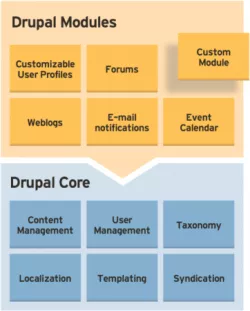FileField Drupal module description
FileField provides a universal file upload field for CCK.
It is a reliable alternative to the core upload module and an essential tool for users uploading large numbers of files. It is particularly well-suited for managing video and audio files, such as podcast content on your site.
Features:
Pathauto Drupal module description
The Pathauto module automatically generates URL/path aliases for various types of content (nodes, taxonomy terms, users) without requiring the user to manually enter the path alias. This allows you to have clean, user-friendly URLs like /category/my-node-title instead of /node/123. The aliases are based on patterns that use tokens, which can be customized by the administrator.
Taxonomy - Drupal taxonomy, what is Taxonomy?
Taxonomy or taxonomic schemes consist of taxonomic units known as taxa or types of things, which are often arranged in a hierarchical structure—typically based on subtype-supertype (parent-child) relationships. In such subtype-supertype relationships, a subtype inherits all constraints of its supertype, plus one or more additional constraints. For example, a car is a subtype of a vehicle. Therefore, every car is also a vehicle, but not every vehicle is a car. A car must satisfy additional requirements beyond being just a vehicle.
Token Drupal module description
Tokens are small pieces of text that can be placed into larger documents through simple placeholders like %site-name or [user]. The Token module provides a centralized API for modules that use these tokens, and it also allows you to define your own token values.
Note that the Token module itself does not provide any user-facing features. It only offers token handling services to other modules.
ImageField Drupal 6 module description
ImageField provides image upload capability to a CCK field. Based on CCK, ImageField is an alternative to legacy image handling tools. It offers features like multiple images per node, resolution constraints, default images, and enhanced support for Views.
ImageField does not provide built-in thumbnail generation but complements the incredibly powerful image generation module ImageCache.
ImageField is associated with:
ImageCache Drupal 6 module description
ImageCache has been moved into the core in Drupal 7. ImageCache allows you to set presets for image processing. If an ImageCache derivative doesn’t exist, a server rewrite rule passes the request to Drupal, which in turn forwards it to ImageCache for dynamic file generation.
ImageCache requires that you:
Image API, Image GD, ImageMagick Drupal modules description
This API interface is intended as a replacement for the image APIs provided by image.inc. You do not need to install this module unless another module requires it. It does not add new features to your Drupal site — it only provides an API that other modules can use. Currently, GD2 and ImageMagick are supported and bundled with ImageAPI.
Note: Requires PHP5!
Differences from Drupal core’s image.inc:
Date, Date Repeat Field, Date All Day Drupal module description
This package provides a flexible Date/Time field, similar to the Date field and Date API used by other modules.
For Drupal versions 5 and 6, the Date field requires a set of CCK modules. In Drupal 7 core, it works by default.
Most of the Calendar module’s functionality comes from the Date module. Therefore, whenever you update the Calendar module, make sure you also update the Date module to the latest version.
Useful information
In this section I will collect articles that do not fit into existing sections, but are very interesting.
Drupal and Multi-Domain Sites
Recently, multi-domain websites have become increasingly popular. For mobile devices, we create a separate domain; for the site's API, we also create a domain. The ability to host part of the site’s functionality on a subdomain allows us to use new features while sharing the same user base and node data with the main site. For example, we have example.org, and for it we create: api.example.org, pda.example.org, and so on.
As you might have guessed, Drupal allows us to implement multi-domain websites without much effort. There are various ways to use Drupal for this:
